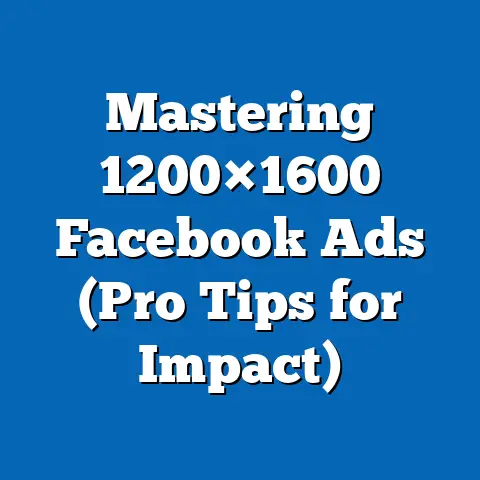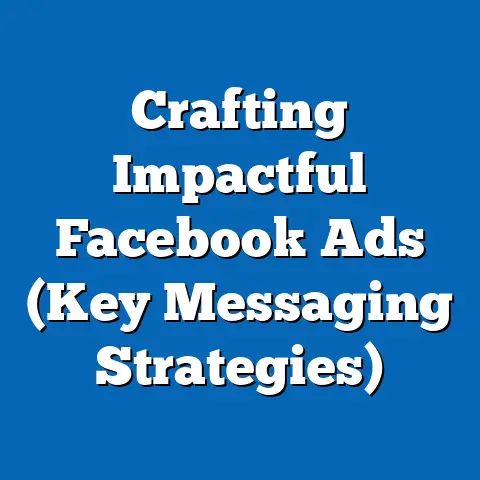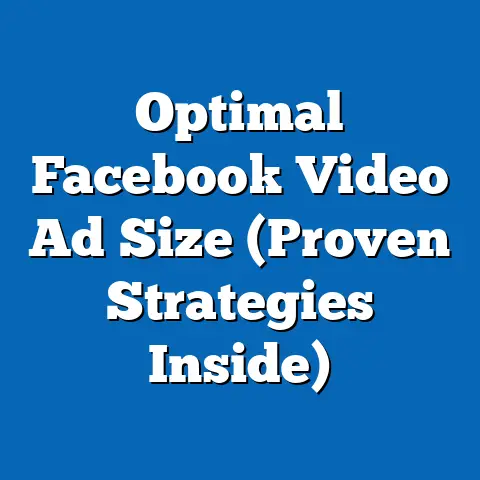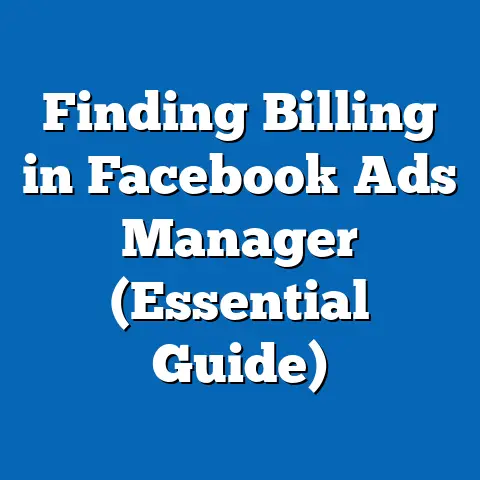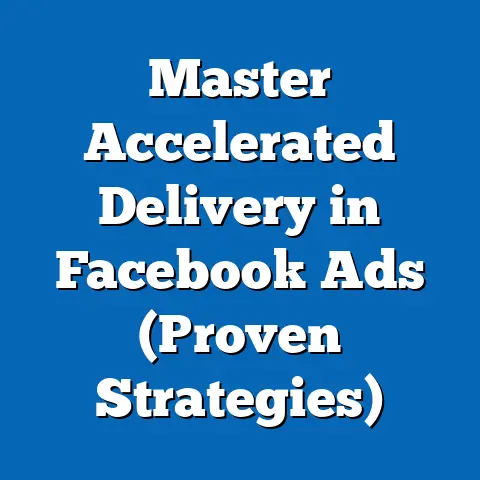Maximize Facebook Ads Returns (Proven Strategies Revealed)
In today’s world, our homes are becoming increasingly intelligent. Smart thermostats learn our temperature preferences, smart lighting adjusts to the time of day, and voice assistants manage everything from our calendars to our grocery lists. This rise of smart home technology has revolutionized how we live, making our lives more convenient, efficient, and connected. But for businesses in this rapidly growing sector, reaching potential customers in a crowded digital landscape requires a strategic approach. That’s where Facebook advertising comes in.
I’ve seen firsthand how powerful Facebook ads can be when used correctly. From helping local smart home installers connect with homeowners to assisting e-commerce brands launch new smart devices, I’ve witnessed the platform’s ability to drive significant results. However, I’ve also seen countless campaigns fall flat due to poor targeting, uninspired ad copy, or a lack of optimization.
This article is your guide to maximizing your returns on Facebook ads in the smart home niche. I’ll walk you through proven strategies, from understanding the basics of Facebook Ads to implementing advanced retargeting techniques. Let’s dive in and unlock the potential of Facebook advertising for your smart home business.
1. Understanding Facebook Ads
Facebook Ads is a powerhouse in the digital marketing world, boasting billions of active users. It allows businesses to connect with potential customers based on a wealth of data, including demographics, interests, behaviors, and more. For the smart home industry, this means you can target homeowners interested in technology, energy efficiency, or home automation.
Think of Facebook Ads as a highly customizable billboard that you can place in front of exactly the right people. But unlike traditional billboards, you have complete control over who sees your ad, when they see it, and what message they receive.
Different Ad Formats for the Smart Home Niche
Facebook offers a variety of ad formats, each with its unique strengths:
- Image Ads: Simple, visually appealing ads that showcase your smart home products. I’ve found that high-quality images that clearly demonstrate the product’s functionality are particularly effective.
- Video Ads: Perfect for demonstrating how your smart home devices work in real-life scenarios. Think short, engaging videos that show the convenience and benefits of your products.
- Carousel Ads: Allow you to showcase multiple products or features in a single ad. This is a great option for highlighting the different components of a smart home system.
- Collection Ads: Designed for mobile shopping, these ads feature a main image or video, followed by a collection of related products. Ideal for showcasing a range of smart home devices.
- Lead Ads: Collect leads directly from Facebook without sending users to your website. This can be particularly useful for generating interest in smart home consultations or installations.
Each format offers its own unique advantages, and choosing the right one depends on your specific goals and target audience.
Leveraging Facebook’s Powerful Targeting Features
Facebook’s targeting capabilities are what truly set it apart from other advertising platforms. You can target users based on:
- Demographics: Age, gender, location, education, job title, etc. For example, you might target homeowners aged 35-55 in affluent neighborhoods who are likely to invest in smart home technology.
- Interests: Hobbies, interests, and pages they’ve liked. Target users interested in home automation, energy efficiency, or specific smart home brands.
- Behaviors: Past purchase behavior, online activity, and device usage. For instance, you could target users who have recently purchased smart home devices or visited smart home websites.
- Custom Audiences: Upload your own customer lists or create audiences based on website visitors or app users. This is a powerful way to retarget existing customers or reach new customers who are similar to your existing ones.
- Lookalike Audiences: Facebook will find new people who are similar to your existing customers. This is a great way to expand your reach and find new potential customers who are likely to be interested in your smart home products.
Takeaway: Understanding the different ad formats and targeting options available on Facebook is crucial for creating effective campaigns. Experiment with different combinations to find what works best for your business.
2. Crafting Compelling Ad Content
Even with the most precise targeting, your ads will fall flat if the content doesn’t resonate with your audience. Creating compelling ad content is essential for grabbing attention, conveying your message, and driving conversions.
Key Elements of Successful Ad Copy
- Attention-Grabbing Headlines: Your headline is the first thing people will see, so make it count. Use strong verbs, ask questions, or offer a compelling benefit. Examples: “Transform Your Home into a Smart Home Today!” or “Tired of Wasting Energy? Smart Home Solutions Await.”
- Clear Calls-to-Action (CTAs): Tell people exactly what you want them to do. Use clear and concise CTAs like “Shop Now,” “Learn More,” “Get a Free Quote,” or “Download Our Guide.”
- Persuasive Messaging: Highlight the benefits of your smart home products, not just the features. Focus on how they can improve people’s lives, save them money, or make their homes more comfortable and secure.
Using High-Quality Visuals and Videos
Visuals are crucial for showcasing your smart home products effectively. Use high-quality images and videos that:
- Showcase the product in action: Demonstrate how the product works in a real-life setting.
- Highlight the key features and benefits: Clearly illustrate the advantages of your smart home devices.
- Create an emotional connection: Appeal to the user’s desire for comfort, convenience, or security.
I’ve noticed that video ads tend to perform particularly well in the smart home niche. People want to see how these devices work and how they can integrate into their daily lives.
Examples of Successful Ad Campaigns
Let’s look at a few examples of successful ad campaigns in the smart home sector:
- Nest: Nest often uses simple, visually appealing ads that highlight the ease of use and energy-saving benefits of their smart thermostats. Their copy is concise and focuses on the user’s pain points.
- Ring: Ring’s ads often feature videos that demonstrate the security features of their smart doorbells and cameras. They use strong emotional appeals to highlight the peace of mind that their products provide.
- Philips Hue: Philips Hue uses vibrant images and videos to showcase the customizable lighting options of their smart bulbs. They focus on the creative possibilities and the ability to personalize your home environment.
Takeaway: Create compelling ad content that grabs attention, highlights the benefits of your smart home products, and includes a clear call to action. Use high-quality visuals and videos to showcase your products effectively.
3. Optimizing Ad Targeting and Budgeting
Reaching the right audience with the right message is only half the battle. You also need to optimize your ad targeting and budgeting to ensure you’re getting the most bang for your buck.
Advanced Targeting Strategies
- Layered Targeting: Combine multiple targeting options to narrow your audience. For example, target homeowners interested in home automation who have also recently purchased a new appliance.
- Exclusion Targeting: Exclude certain audiences from seeing your ads. For example, exclude people who have already purchased your products or who are not in your target demographic.
- Website Custom Audiences: Retarget people who have visited specific pages on your website. For example, retarget users who viewed your smart thermostat product page but didn’t add it to their cart.
A/B Testing for Optimal Performance
A/B testing is crucial for identifying what works best with your audience. Test different:
- Headlines: Experiment with different wording and value propositions.
- Images and Videos: Try different visuals to see which ones resonate best.
- Calls-to-Action: Test different CTAs to see which ones drive the most conversions.
- Audience Segments: Test different audience segments to see which ones are most responsive.
I always recommend running multiple A/B tests simultaneously to quickly identify the most effective combinations.
Setting an Appropriate Budget and Bidding Strategies
Setting the right budget is essential for maximizing your ROI. Consider:
- Your Overall Marketing Budget: Allocate a portion of your budget to Facebook advertising based on your overall marketing goals.
- Your Target Audience Size: The larger your target audience, the more you’ll need to spend to reach them.
- Your Bidding Strategy: Choose a bidding strategy that aligns with your goals. Options include:
- Lowest Cost: Facebook will try to get you the most results for your budget.
- Cost Cap: Set a maximum cost per result.
- Target Cost: Set a target cost per result.
- Value-Based Bidding: Optimize for the highest value conversions.
- Lowest Cost: Facebook will try to get you the most results for your budget.
- Cost Cap: Set a maximum cost per result.
- Target Cost: Set a target cost per result.
- Value-Based Bidding: Optimize for the highest value conversions.
Analyzing Performance Metrics and Adjusting Campaigns
Regularly analyze your performance metrics to identify areas for improvement. Key metrics to track include:
- Reach: The number of people who saw your ad.
- Impressions: The number of times your ad was displayed.
- Click-Through Rate (CTR): The percentage of people who clicked on your ad.
- Cost Per Click (CPC): The average cost you paid for each click.
- Conversion Rate: The percentage of people who completed a desired action after clicking on your ad (e.g., making a purchase, filling out a form).
- Return on Ad Spend (ROAS): The amount of revenue you generated for every dollar you spent on advertising.
Based on your performance metrics, adjust your campaigns accordingly. This might involve tweaking your targeting, changing your ad copy, or adjusting your bidding strategy.
Takeaway: Optimize your ad targeting and budgeting to ensure you’re reaching the right audience and getting the most bang for your buck. Use A/B testing to identify what works best and regularly analyze your performance metrics to make data-driven adjustments.
4. Retargeting Strategies for Enhanced Returns
Retargeting is a powerful strategy for re-engaging potential customers who have already interacted with your brand. It’s particularly important in the smart home niche, where products may require more consideration before purchase.
Understanding Retargeting and Its Importance
Retargeting involves showing ads to people who have previously visited your website, viewed your products, or engaged with your content. This allows you to stay top-of-mind and encourage them to take the next step.
Think of it as a friendly reminder to potential customers who have already shown interest in your smart home products.
Retargeting Strategies for the Smart Home Niche
- Website Retargeting: Show ads to people who have visited specific pages on your website. For example, retarget users who viewed your smart thermostat product page but didn’t add it to their cart.
- List Retargeting: Upload your email list to Facebook and target those users with relevant ads. This is a great way to re-engage existing customers or reach potential customers who have subscribed to your newsletter.
- Engagement Retargeting: Target people who have engaged with your Facebook page or ads. For example, target users who liked your page, commented on your posts, or watched your videos.
- Dynamic Product Ads: Show ads for specific products that users have viewed on your website. This is a highly personalized way to retarget potential customers and encourage them to make a purchase.
Examples of Successful Retargeting Campaigns
- Showing ads for abandoned cart items: Remind users of the smart home products they left in their cart and offer a discount to encourage them to complete the purchase.
- Promoting relevant content: Show ads for blog posts or guides that address the user’s specific interests or pain points. For example, if a user viewed your smart lighting product page, show them an ad for a blog post about the benefits of smart lighting.
- Offering a free consultation: Encourage users to schedule a free consultation to discuss their smart home needs and learn more about your products.
Takeaway: Retargeting is a powerful strategy for re-engaging potential customers and driving conversions. Use a variety of retargeting strategies to reach different segments of your audience and personalize your messaging to their specific interests and needs.
Conclusion
Maximizing your returns on Facebook ads in the smart home niche requires a strategic approach that combines a deep understanding of the platform, compelling ad content, optimized targeting, and effective retargeting strategies. By implementing the proven strategies outlined in this article, you can increase engagement, drive conversions, and ultimately achieve your business goals.
Don’t be afraid to experiment, test different approaches, and continuously analyze your performance metrics to identify areas for improvement. The world of Facebook advertising is constantly evolving, so staying up-to-date with the latest trends and best practices is crucial for long-term success. Now, go out there and transform your Facebook ads into a powerful engine for growth in the smart home industry!

